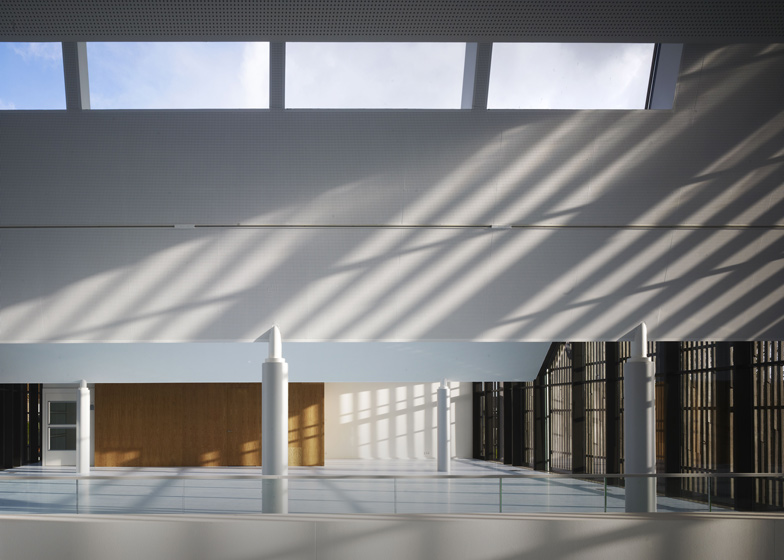This maritime museum in the Netherlands by Dutch studio Mecanoo features reclaimed wooden cladding and a zig-zagging roof that reference the gabled houses of the surrounding hamlet (+ slideshow).
Mecanoo completed the Kaap Skil, Maritime and Beachcombers Museum in Oudeschild, on the island of Texel. The angular roof profile was designed to match the rhythms of a group of harbour-side buildings, while the louvred wooden facade relates to the driftwood used by locals to build their homes.
Sheets of recycled hardwood were sawn into strips to create the louvres, which allow daylight to filter through to a ground-floor cafe and a first-floor gallery.
"The wooden slats used in the facades come from tropical hardwood piling from the North Holland Canal," said the architects. "The un-sawed edges have been deliberately placed on the visible side of the facade. After forty years of residence under water the white, grey, rust-red, purple and brown colours are beautifully weathered."
The large upper gallery is dedicated to underwater archaeology. There's also a second exhibition space in the basement to present the history of Reede van Texel - a historic offshore anchorage used by the fleet of the Dutch East India Company.
"The entrance and the museum cafe form a natural frontier between the world of the Reede van Texel in the basement and that of the underwater archaeology on the first floor," explained the architects.
The museum was completed in 2011 and is nominated for an award at this year's World Architecture Festival, which takes place in Singapore next month.
Mecanoo most recently completed Europe's largest public library in Birmingham, England, where studio founder Francine Houben told Dezeen: "Libraries are the most important public buildings". See more architecture by Mecanoo »
Other maritime museums published on Dezeen include one in Portugal dedicated to cod fishing and one in England housing the remains of a sixteenth century warship. See more museums »
Photography is by Christian Richters, apart from where otherwise stated.
Here's some more information from Mecanoo:
Kaap Skil, Maritime and Beachcombers Museum, Texel, the Netherlands
Tourist Attraction
The island of Texel is situated in the Waddenzee and is the largest of the Dutch Wadden Islands. Every year a million or so tourists visit the island, which is only accessible by plane, boat or ferry. Few however will be familiar with the glorious history of Texel and its links with the Dutch East India Company. In the seventeenth and eighteenth centuries the Company's fleet used the anchorage of Texel as its departure point for expeditions to the Far East. The ships waited there for a favourable wind before weighing anchor and sailing off to the 'Orient'. While they waited, maintenance work and small repairs were carried out, victuals and water were brought on board and family could see their loved ones one last time.
Many painters visited the 'Reede van Texel' (the offshore anchorage of Texel) to depict on canvas the fleet of the Dutch Republic. In the new entrance building of the maritime and beachcombers museum, Kaap Skil, in the hamlet of Oudeschild, the public is taken back in time to the Dutch Golden Age. The showpiece of the museum is an eighteen-metre long, four-metre deep model of the Reede van Texel, displaying in great detail the impressive spectacle of the dozens of ships anchored off the coast of the Wadden Island.
Typical gable roofs
The museum is designed with four playfully linked gabled roofs which are a play on the rhythm of the surrounding rooftops which, seen from the sea, resemble waves rising out above the dyke.
'The sea takes away and the sea provides' – this is a saying that the people of Texel know so well. For hundreds of years they have made grateful use of driftwood from stranded ships or wrecks to build their houses and barns. The wooden façade of Kaap Skil is a good example of this time-hallowed tradition of recycling. The vertical wooden boards are made of sawn hardwood sheet-piling from the North Holland Canal and have been given a new life just like the objects in the museum collection.
From within, the glass facade in front of the wooden boards allows an inviting view of the outdoor museum terrain and of the famous North Holland skies to visitors of the museum café. Inside the building the boards cast a linear pattern of daylight and shadow creating an atmosphere infused with light and shelter.
Daylight and artificial light
The entrance and the museum café form a natural frontier between the world of the Reede van Texel in the basement and that of the underwater archaeology on the first floor. The contrast between the two worlds is reinforced by the different experiences of light and space. In the basement visitors are drawn around the exhibition by projections and animations, creating an intimate space that harbours a sense of mystery. On the first floor the North Holland sky floods the objects on display with light. The movable showcases of robust steel frames and glass create a transparent effect so that the objects in the collection seem to float within the space. Under the high gabled roofs the visitor gets a generous sense of being able to survey the sizable collection, the museum grounds and the village of Oudeschild at a glance.
Client: Maritiem & Jutters Museum, Oudeschild
Architect: Mecanoo architecten, bv
Museum design: Kossmann.dejong, Amsterdam
Project management: ABC Management Groep, Assen
Builders: Pieters Bouwtechniek, Utrecht
Installations consultant: Peter Prins, Woerden
Contractors: Bouwcombinatie De Geus & Duin Bouwbedrijf, Broek op Langedijk
Installations: ITBB, Heerenveen
Sawmills for wooden cladding of façades: Pieter Dros, Texel













